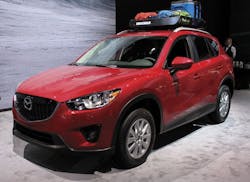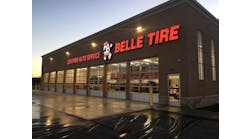Expect to stock, and sell, more do-it-all tires for today’s want-it-all consumers. Crossover utility vehicle (CUV) owners demand comfortable, smooth rides; but they also want to haul lumber from the hardware store on the weekend. They expect the fuel-efficiency of a sedan, but are looking for more space so there’s room for neighbor kids to tag along on an afternoon adventure. They like the view from seats that are higher, but don’t want the rough ride of a truck. In short, they want it all.
The versatility of CUVs and their big brothers — sports utility vehicles (SUVs) — is driving the sales market, and as a result, it’s putting plenty of pressure on original equipment tire manufacturers to create tires with car-like features and benefits.
Tire companies don’t see this bubble bursting any time soon. “The focus at the OE is very heavy on the SUV/CUV market,” says David Colletti, vice president of OE in the NAFTA region for Pirelli Tire North America Inc. “As the market continues to grow for utility vehicles, we see more emphasis on these vehicles over sedans or other typical cars.”
Mike Martini is president of OE sales in the U.S. and Canada for Bridgestone Americas Tire Operations LLC. “The CUV segment is the fastest-growing part of the market right now, and we anticipate that this trend will continue for the next several years.”
In May 2014, for the first time, new vehicle registrations for CUVs and SUVs eclipsed those of sedans in the U.S., according to IHS Automotive, a part of IHS Inc. The flip ended the sedan’s dominance of many decades, as IHS notes CUV and SUV registrations grew from 31.4% of the market in May 2009 to 36.5% in May 2014. In that same time frame, sedans fell from 36.3% to 35.4%, and pickups, hatchbacks, vans, coupes and convertibles also all dropped. Station wagons grabbed a slightly larger share, increasing from 1.1% to 1.2% market share over the six-year period.
Most tire manufacturers holding a share of the OE market say they’re finishing up fitments for model year 2019 vehicles and working ahead to vehicles for 2020 and beyond. Given the record length consumers are keeping their vehicles on the road, the tires on the OE drawing board today will drive the replacement tire market until at least 2030.
Fuel economy is king
Corporate Average Fuel Economy (CAFE) standards are playing a big role in the design of SUVs and CUVs, and auto manufacturers are counting on their tire-making partners to help them meet the 2025 fuel efficiency requirement of 54.5 miles per gallon in passenger cars and light trucks.
Stacy Lindsey, OE marketing manager for SUVs and CUVs for Michelin North America Inc., says, “Rolling resistance is as key in these segments as in passenger cars. At the same time, original equipment manufacturers do not want to compromise dry traction and handling. As a result, there are more demands in this segment for good performance and fuel economy.”
Each of the OE providers who responded to Modern Tire Dealer’s request for information about OE fitments on SUVs and CUVs highlighted fuel efficiency as a top priority. But Martini from Bridgestone says that shouldn’t be a surprise.
“Fuel economy improvements are king in every vehicle segment of the OE market, and each tire manufacturer is trying to maximize their OE fitments without compromise,” Martini says. “What we are seeing is that vehicle manufacturers want a good balance of improved fuel economy, or low rolling resistance, with stopping distance performance staying the same, or perhaps even improved.”
Andrew Zeisser, director of OE sales for Yokohama Tire Corp., sees CAFE standards influencing auto manufacturers just as oil prices will affect what kind of vehicles consumers will choose in the future. “U.S. consumers prefer the room and utility of SUV and CUV models,” Zeisser says. “Consumers will continue to purchase these over sedans as long as oil prices remain relatively low. However, the latest CAFE requirements for 2025 may force manufacturers to downsize toward CUVs, or even sedans.”
Enno Straten, vice president of original equipment consumer tire accounts for Continental Tire the Americas LLC, doesn’t see downsizing on the horizon.
“Both SUV and CUV segments are growing and gaining more importance in the market,” Straten says, noting CUVs are outpacing SUVs. “Both are still very dominant in the automotive industry.”
Bruce Sanborn, product segment manager for Cooper Tire & Rubber Co., says while the marching orders for fuel efficiency from auto manufacturers are clear, SUV and CUV owners see the road ahead a bit differently.
“While the traditional SUV consumer understands that their vehicle choice may not always be the most fuel efficient, the CUV consumer is a little more demanding when it comes to fuel efficiency. They have the same fuel efficiency expectations as a passenger car owner.”
Cooper, a relative newbie to the OE world, says the popularity of CUVs has served as a worthwhile challenge for the company’s engineers. Sanborn used Cooper’s newest CUV tire, the Discoverer SRX, as an example. “The objective of the Discoverer SRX was to expand into this growing CUV segment. But the challenge was not just in providing sizes, but providing the performance characteristics this consumer expects out of their crossover vehicles.
“In terms of ride, wet, dry and winter performance, the CUV segment is almost an extension of the passenger touring segment. The demand is that performance shouldn’t be limited in any one particular area,” Sanborn says.
“The CUV consumer expects quiet all-season performance capabilities, yet durable performance on a multitude of terrains with the ability to carry the cargo capacity these vehicles are designed for. The CUV is an all-purpose utility vehicle, and the demands placed upon the tires are great, and the ability to serve this market has expanded Cooper’s design and technology innovation.”
More tire sizes, or fewer? It depends
The popularity of CUVs, in particular, is contributing to an expansion of the range of tire sizes for SUVs and CUVs. There are hints that some auto manufacturers are ready to begin carrying over sizes from one year to the next, but differing trim levels and aesthetic personalities also are contributing to an ever-expanding lineup.
“Rim sizes range from 17 to 22 inches, with section widths from 215 on small CUVs to 325 on a BMW X5/X6M,” says Lindsey from Michelin. “Nearly every new generation has been stepping up one rim size for the last several models. It would appear that this trend would begin to stabilize. The size mix is diverse, especially among the European manufacturers. We haven’t seen the tall and narrow trend take off yet, but we are watching it closely as the CAFE requirements become more challenging.”
Martini from Bridgestone expects one rim size in particular to become more popular than the others.
“We will see many more 21-inch rim diameter tires in the future,” he says. “Larger rim sizes are a big trend in the market as consumers appreciate the aesthetic that they deliver.”
“We see a general trend toward OEMs carrying over existing tire sizes to future programs with new performance requirements,” says Straten from Continental. “Sometimes for styling reasons tire diameter or width changes one step up or down.”
And like his comrade at Bridgestone, Straten from Continental says the larger sizes are becoming more popular. “We also see more and more 21-inch and 22-inch sizes, but typically at low volume on high end trim levels.”
Pirelli’s OE customers are still ordering more sizes of tires. “The range of sizes is continuing to expand,” says Colletti. “We see rim fitments ranging from 17 inches up to 22 inches. The complexity is increasing as the OEs are using tires to differentiate vehicle trim levels. Therefore, we are not seeing a reduction in the number of tires being offered.”
The OE contracts at Yokohama are showing the same trend. “Tire sizing for these segments continues to grow, with 18-inch and higher wheel diameters taking a major share of new fitments,” says Zeisser.
The expanse of tire sizes also includes higher speed ratings, says Cooper’s Sanborn.
“Vehicle manufacturers are also increasing the speed ratings of the OE tire,” Sanborn says. “The traditional SUV market was primarily made up of S and T speed-rated sizes. Today, it is not uncommon to have H- or V-speed-rated fitments in this segment.” ■
Honda CR-V: the best-selling utility vehicle
The Honda CR-V holds a commanding lead over every other utility vehicle sold in the U.S. And according to new car sales figures compiled by Good Car Bad Car, the CR-V is sandwiched between Honda Motor Co. Ltd.’s two most iconic sedans. Most recent sales figures show the CR-V is outselling both the Accord and the Civic.
In August 2015, CR-V sales increased 2% compared to August 2014 figures, while Accord sales tanked 19.9% and Civic sales fell 5.9%. August 2015 was the best sales month ever for the CR-V, the automaker says.
The year-to-date figures for the CR-V are even better than the monthly ones — up 5.7% (from 217,293 in August 2014 to 229,574 in August 2015.)
Good Car Bad Car reports the year-to-date numbers for the Accord and Civic are both trending downward, but they’re not quite as bad as the month-to-month comparisons. The Accord is down 14.8% and Civic sales have fallen 4.2%.
One thing the last five years of the CR-V doesn’t show is the industry’s proliferation of tire sizes. According to Honda’s specification charts for the 2010 to 2015 model years, the EX and the EX-L trim levels have come equipped with the same tire size: 225/65R17. The LX used that size in 2010 and 2011, but switched to 215/70R16 in 2012. The CR-V added a fourth trim level, the Touring, in 2015, with 225/60R18 tires.
The other top priorities in SUV and CUV tires
Automakers are depending on tire manufacturers to help deliver improved fuel economy on future generations of sports utility and crossover utility vehicles. But the tire companies say there are five other qualities just as important to consumers:
- handling,
- stopping,
- noise,
- durability, and
- grip.
Stacy Lindsey, original equipment marketing manager for SUVs and CUVs for Michelin North America Inc., says both utility vehicle types have different requirements. With more “sport” trim levels on CUVs, handling and stopping is emphasized, while the larger SUVs, built on truck platforms, focus more on comfort and safety.
Noise reduction is a trait that likely will become even more critical in OE tire orders.
“Original equipment manufacturers are engineering lighter weight vehicles to deliver fuel economy benefits,” says Mike Martini, president of OE sales in the U.S. and Canada for Bridgestone Americas Tire Operations LLC.
“When you lighten the vehicle, structural tire noise becomes more of an issue, so we’ll have to become even more sophisticated in our noise reduction tire technologies.”



